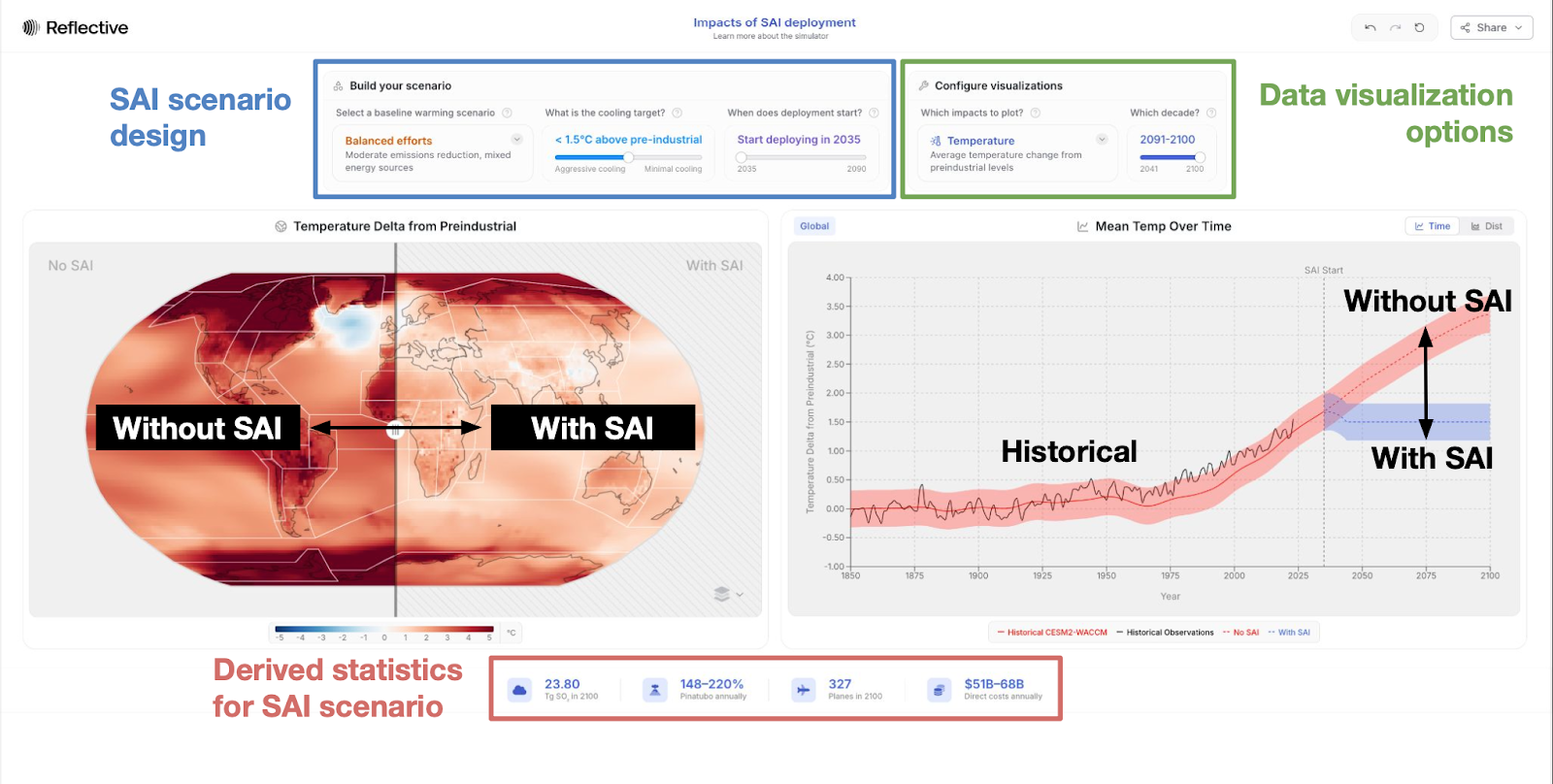Exploring Sunlight Reflection: Introducing the SAI Simulator
Since first releasing the SAI Simulator v1.0, we’ve been hard at work developing some exciting new features that we expect to roll out in a matter of weeks.
In the meantime, we wanted to take a step back to explain why we’ve been working on the Simulator in the first place. (This is expanded in greater detail in our post from last year, and in a new preprint about the Simulator here.)
First, some bad news. Even if we dramatically cut global carbon emissions today, it appears we are highly likely to overshoot our goal to limit warming to 1.5 ℃ above pre-industrial levels within the decade, if we haven’t already. The extent and the duration of an overshoot matters significantly. A very brief overshoot could be manageable, but a serious and sustained overshoot could trigger multiple catastrophic “tipping points” that irreversibly alter our planet and challenge the human climate “niche.”
Sunlight reflection is one promising way to mitigate the worst effects of climate change, working alongside decarbonization to buy us time. The term refers to deliberate measures to decrease the amount of incoming sunlight, which in turn decreases average surface temperatures. These methods of intentional, planetary-scale intervention are likely to get much more attention as our situation worsens in the coming decades.
One of the best known methods for planet-scale sunlight reflection is stratospheric aerosol injection, or SAI. SAI involves dispersing sulfur-based aerosols from aircraft high up in the atmosphere. These particles would stay aloft for some time (up to years), and reflect solar energy back into space. This method of cooling already occurs naturally—major volcanic eruptions have a temporary cooling effect on the planet due to their sulfur emissions.
Researchers believe with high confidence that SAI can work to cool the planet and avoid the worst effects of climate change. But it’s nowhere near clear yet whether we should deploy SAI, or what the impacts would be. We do know that impacts will be unevenly distributed—for example, some regions may see higher rainfall, while others see less. And the distribution of those impacts would depend on operational details like when, where, and how atmospheric injection occurs.
Fortunately, climate model simulations can help give researchers useful insights. When coupled with observations of past volcanic eruptions, simulations can help us understand the potential impacts of SAI, how they vary under different deployment scenarios, and how they compare to possible future warming scenarios without SAI.
To date, interrogating those models and simulations has required expertise and specialized knowledge. At Reflective, we believe that everyone—researchers, policymakers, and the general public—should be able to understand and explore how SAI might affect the planet. It’s not enough for researchers to publish figures in academic journals. We must improve access to the latest scientific understanding in order to enable good, informed decisions.
Our first step towards this goal is what we’re calling our SAI Simulator v1.0. It’s an interactive, web-based tool based on state-of-the-art climate modeling that allows anyone with a web browser to explore our best understanding of SAI and how it might affect our planet.

Here’s what you can do with the Simulator:
- Build an SAI deployment scenario. First, you choose a “baseline” scenario. For these, we’ve chosen a standard set of scenarios called Shared-Socioeconomic Pathways (SSPs), which are used by the IPCC. Think of these as a globally agreed-upon set of storylines about what the future could be like, including future carbon emissions. Then, you set a global cooling target and when you want the cooling to start.
- See the effects on global climate. What happens to temperature, water availability and climate extremes, how much do they vary regionally, and how does this compare to the outcomes of your baseline scenario?
- Understand the logistics and costs of your scenario. How many planes would this take? How much aerosol? What would this deployment cost?
The Simulator uses data from the Community Earth Systems Model 2 (CESM2), which is one of the most rigorously validated models for SAI simulations to date. However, the Simulator v1.0 is far from a complete representation of the risks of SAI, and we plan to continuously add new features and information as scientists learn more. For more information about its design and current limitations, you can read our preprint here.
The scenarios we’ve run consistently show that SAI does have the potential to cool the planet, that impacts will vary regionally and will depend on how it might be deployed. But the purpose of the tool is to allow exploration, and we want to learn more about how you are using it. If you have questions, feedback, or ideas for features you’d like to see in future versions, please get in touch.
We’re very proud of the work that’s gone into the tool to date, and are thankful for our collaborators. In particular, we would like to thank Jürg Luterbacher, Ping-Ping Narenpitak, Athar Hussain, Franklin Opijah, the Climate team at Stripe and Frontier, Andrew Jones, and Andy Parker.
All the data used by the Simulator and the code behind it are publicly available under an Apache 2.0 license. You can find links to the datasets and code in our GitHub repository.
We look forward to sharing further updates with you soon. If you’d like to stay in touch, feel free to sign up for our mailing list.